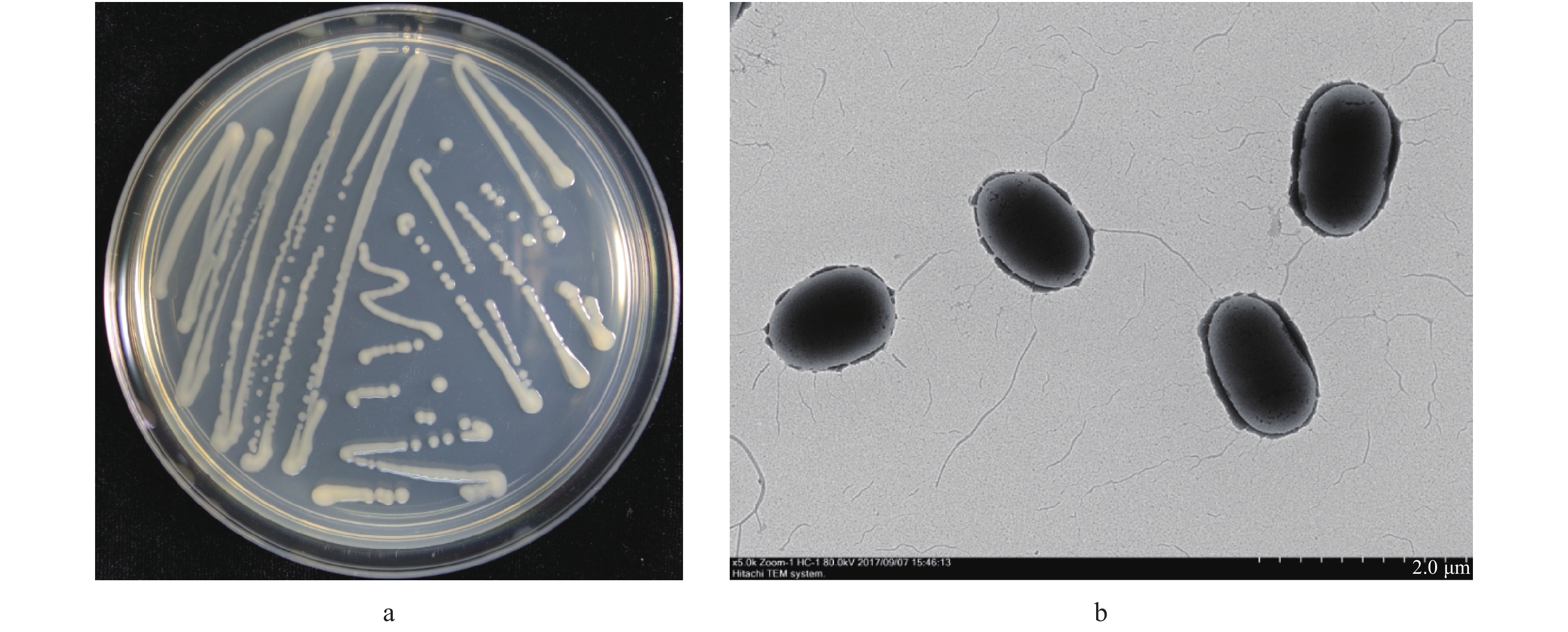Identification of a Pathogen of Bacterial Pith Necrosis in Tomatoes
-
摘要:
目的 对2017–2019年在福建、浙江等地大棚种植的番茄上发现的一种引起番茄细菌性髓部坏死病的新病害进行病原鉴定,为该病害的防治奠定基础。 方法 采用Biolog法、16S rDNA基因序列测定及MALDI-TOF-MS等方法对分离的病原菌进行种属鉴定;利用柯赫氏法则进行病原菌的致病性测定。 结果 从田间番茄细菌性髓部坏死病发病植株上分离保存了2个代表性细菌菌株,将2个菌株接种至番茄幼苗上,它们均可侵染番茄植株,造成茎杆维管束褐变,茎髓部组织腐烂、空心,并最终导致整株植株萎蔫死亡。该症状与田间自然发病症状相同,并从回接发病植株上重新分离到相同的病原细菌。经Biolog法、16S rDNA基因序列测定及MALDI-TOF-MS等方法确认该病原菌为阿氏肠杆菌(Enterobacter asburiae)。 结论 福建、浙江等地大棚种植的番茄上发现的引起番茄细菌性髓部坏死病的病原菌为阿氏肠杆菌,该发现尚属国内外首次报道。 -
关键词:
- 番茄髓部坏死病 /
- 病原鉴定 /
- Biolog法 /
- MALDI-TOF-MS分析 /
- 阿氏肠杆菌
Abstract:Objective The pathogen that caused the bacterial pith necrosis on greenhouse tomatoes grown in Fujian and Zhejiang provinces during 2017-2019 was identified. Method Biolog analysis, 16S rDNA gene sequencing, and MALDI-TOF-MS were performed to identify the pathogen. The Koch’s rule was employed to determine the pathogenicity of the isolate. Result Two bacteria strains were isolated from the diseased tomatoes. The symptoms of discolored, dark brown vascular tissue and pith of main stem observed on tomatoes in the laboratory were identical to those found in the field. The bacteria were re-isolated from the infected plants and identified as Enterobacter asburiae. Conclusion The pathogen that caused bacterial pith necrosis in tomatoes in Fujian and Zhejiang was identified and reported as E. asburiae for the first time. -
Key words:
- Tomato pith necrosis /
- pathogen identification /
- Biolog analysis /
- MALDI-TOF-MS /
- Enterobacter asburiae
-
表 1 Biolog分析结果
Table 1. Results of biology analysis
编号 No. 参数 Parameters 物种 Species 可能性
PROB相似性
SIM位距
DISFJAT-46819 0.5 0.5 6.0 肠杆菌属(Enterobacter spp.) FJAT-47134 0.6 0.6 5.1 肠杆菌属(Enterobacter spp.) 表 2 菌株FJAT-46819 和FJAT-47134的MALDI-TOF-MS鉴定结果
Table 2. Results of MALDI-TOF-MS analysis on FJAT-46819 and FJAT-47134
编号
No.鉴定
Identification菌株名称
Strains匹配值(可信度)
Matching value
(credibility score)标记
MarkFJAT-46819 Enterobacter asburiae
CCM 4032 CCM阿氏肠杆菌 2.326 +++ FJAT-47134 Enterobacter asburiae
CCM 4032 CCM阿氏肠杆菌 2.333 +++ 注:匹配值2.300-3.000表示菌株鉴定结果可靠(标记为“+++”)。
Note: Matching values of 2.300-3.000, marked by +++, indicate accurate identification of tested strain. -
[1] SRINIVAS C, NIRMALA D D, NARASIMHA M K, et al. Fusarium oxysporum f. sp. lycopersici causal agent of vascular wilt disease of tomato: Biology to diversity- a review [J]. Saudi Journal of Biological Sciences, 2019, 26: 1315−1324. doi: 10.1016/j.sjbs.2019.06.002 [2] ELSHARKAWY M, DERBALAH A, HAMZA A, et al. Zinc oxide nanostructures as a control strategy of bacterial speck of tomato caused by Pseudomonas syringae in Egypt [J]. Environmental Science and Pollution Research, 2020, 27(16): 19049−19057. doi: 10.1007/s11356-018-3806-0 [3] FIALLO-OLIVÉ E, NAVAS-CASTILLO J. Tomato chlorosis virus, an emergent plant virus still expanding its geographical and host ranges [J]. Molecular Plant Pathology, 2019, 20(9): 1307−1320. doi: 10.1111/mpp.12847 [4] IM S M, YU N H, JOEN H W, et al. Biological control of tomato bacterial wilt by oxydifficidin and difficidin-producing Bacillus methylotrophicus DR-08 [J]. Pesticide Biochemistry and Physiology, 2020, 163: 130−137. doi: 10.1016/j.pestbp.2019.11.007 [5] NANDI M, MACDONALD J, LIU P, et al. Clavibacter michiganensis ssp. michiganensis: bacterial canker of tomato, molecular interactions and disease management [J]. Mol Plant Pathol, 2018, 19: 2036−2050. doi: 10.1111/mpp.12678 [6] 佘小漫, 汤亚飞, 何自福, 等. 番茄细菌性髓部坏死病病原的鉴定 [J]. 植物病理学报, 2017, 47(2):180−186.SHE X M, TANG Y F, HE Z F, et al. Identification of the pathogen causing tomato bacterial pith necrosis in Guangdong [J]. Acta phytopathologica sinica, 2017, 47(2): 180−186.(in Chinese) [7] ADHIKARI P, ADHIKARI T B, TIMILSINA S, et al. Phenotypic and genetic diversity of Xanthomonas perforans populations from tomato in north carolina [J]. Phytopathology, 2019, 109: 1533−1543. doi: 10.1094/PHYTO-01-19-0019-R [8] XIN X F, KVITKO B, HE S Y. Pseudomonas syringae: what it takes to be a pathogen [J]. Nature Reviews Microbiology, 2018, 16: 316−328. doi: 10.1038/nrmicro.2018.17 [9] TIMILSINA S, ADKISON H, TESTEN A L, et al. A novel phylogroup of Pseudomonas cichorii identified following an unusual disease outbreak on tomato [J]. Phytopathology, 2017, 107(11): 1298−1304. doi: 10.1094/PHYTO-05-17-0178-R [10] POWELL M, GUNDERSEN B, MILES C A, et al. First report of tomato pith necrosis (Pseudomonas corrugata) on tomato (Solanum lycopersicum) in Washington [J]. Plant Disease, 2013, 97: 1381. [11] MOLAN Y, IBRAHIM Y. First report of tomato (Lycopersicon esculentum) pith necrosis caused by Pseudomonas fluorescens andP. corrugata in the kingdom of Saudi Arabia [J]. Plant Disease, 2007, 91(1): 110. [12] MALATHRAKIS N E, GOUMAS D E. Bacterial soft rot of tomato in plastic greenhouses in Crete [J]. Annals of Applied Biology, 1987, 111: 115−123. doi: 10.1111/j.1744-7348.1987.tb01438.x [13] TRANTAS E A, SARRIS P F, MPALANTINAKI E E, et al. A new genomovar of Pseudomonas cichorii, a causal agent of tomato pith necrosis [J]. European Journal of Plant Pathology, 2013, 137(3): 477−493. doi: 10.1007/s10658-013-0258-8 [14] BUCHANAN R E, GIB-BONS N E. Identification manual of Berger bacteria[M]. The 8th. Translated by Institute of Microbiology of CAS, 1984. [15] DAVIN-REGLI A, LAVIGNE J P, PAGÈS J M. Enterobacter spp. : Update on taxonomy, clinical aspects, and emerging antimicrobial resistance [J]. Clinical Microbiology Reviews, 2019, 32(4): e00002−19. [16] GARCÍA-GONZÁLEZ T, SÁENZ-HIDALGO H K, SILVA-ROJAS H V, et al. Enterobacter cloacae, an emerging plant-pathogenic bacterium affecting Chili Pepper seedlings [J]. Plant Pathology Journal, 2018, 34: 1−10. doi: 10.5423/PPJ.OA.06.2017.0128 [17] ZHU B, LOU M M, XIE G L, et al. Enterobacter mori sp. nov., associated with bacterial wilt on Morus alba L. [J]. International Journal of Systematic and Evolutionary Microbiology, 2011, 61: 2769−2777. doi: 10.1099/ijs.0.028613-0 [18] MURDOCH C W, CAMPANA R J. Bacterial species associated with wet wood of elm [J]. Phytopathology, 1983, 73: 1270−1273. doi: 10.1094/Phyto-73-1270 [19] DICKEY R S, ZUMOFF C H. Emended description of Enterobacter cancerogenus comb. nov (Formerly Erwiniacancerogena) [J]. International Journal of Systematic Bacteriology, 1988, 38: 371−374. doi: 10.1099/00207713-38-4-371 [20] SCHWARTZ H F, OTTO K. First report of a bulb decay of onion by Enterobacter cloacae in Colorado [J]. Plant Disease, 2000, 84(7): 808. [21] NISHIJIMA K A, ALVAREZ A M, HEPPERLY P R. Association of Enterobacter cloacae with rllizome rot of edible ginger in Hawaii [J]. Plant Disease, 2004, 88: 1318−1327. doi: 10.1094/PDIS.2004.88.12.1318 [22] KEITH R C, NISHIJIMA K A, KEITH L M, et al. Atypical internal yellowing of Papaya fruit in Hawaii caused by Enterobacter sakazakii [J]. Plant Disease, 2008, 92(3): 487. [23] SCHROEDER B K, DU TOIT L J, SCHWARTZ H F. First report of Enterobacter cloacae causing onion bulb rot in the Columbia basin of Washington state [J]. Plant Disease, 2009, 93(3): 323. [24] WANG G F, PRAPHAT K, XIE G L, et al. Bacterial wilt of mulberry (Morus alba) caused by Enterobacter cloacae in China [J]. Plant Disease, 2008, 92: 483. [25] WANG G F, XIE G L, ZHU B, et al. Identification and characterization of the Enterobacter complex causing mulberry (Morus alba) wilt disease in China [J]. European Journal of Plant Pathology, 2010, 126(4): 465−478. doi: 10.1007/s10658-009-9552-x [26] ZHU B, WANG G F, XIE G L, et al. Enterobacter spp. : New evidence of mulberry blight disease [J]. Science in China press: Life science, 2009, 39: 211−219. [27] 戴凡炜, 罗国庆, 王振江, 等. 华南蚕区桑枯萎病病原菌的分离与分子鉴定 [J]. 蚕业科学, 2012(3):981−987.DAI F W, LUO G Q, WANG Z J, et al. Isolation and molecular identification of the pathogen causing mulberry wilt disease in southern sericultural areas of China [J]. Acta Sericologica Sinica, 2012(3): 981−987.(in Chinese) -








 下载:
下载:




